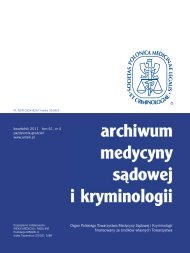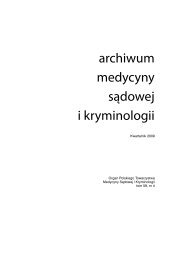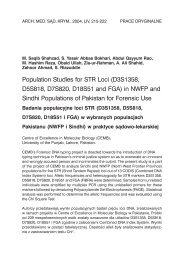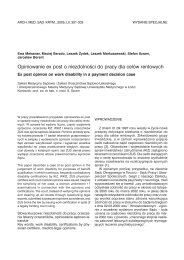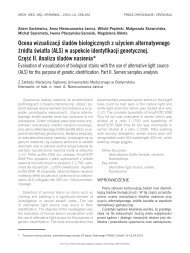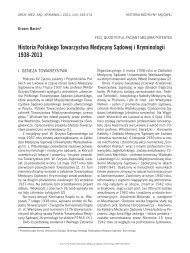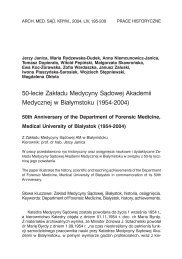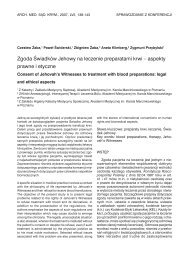PeÅny numer do pobrania (*.pdf) - Archiwum Medycyny SÄ dowej i ...
PeÅny numer do pobrania (*.pdf) - Archiwum Medycyny SÄ dowej i ...
PeÅny numer do pobrania (*.pdf) - Archiwum Medycyny SÄ dowej i ...
Create successful ePaper yourself
Turn your PDF publications into a flip-book with our unique Google optimized e-Paper software.
96 Łukasz Szleszkowski, Agata Thannhäuser, Jerzy Kawecki, Krzysztof Szwagrzyk, Barbara Świątek<br />
Nr 2<br />
they were tied up) and hit his face on a hard surface.<br />
In six cases, the arrangement of the upper extremities<br />
in the grave (beneath the trunk) indicated<br />
a possibility of the prisoner’s arms being tied behind<br />
his back.<br />
DISCUSSION<br />
In none of the 38 cases of gunshot injuries inflicted<br />
in the course of executing the death penalty<br />
”by shooting” any injuries were noted that would<br />
correlate with the then regulation description<br />
method of court-enforced execution. All the analyzed<br />
cases involved gunshot injuries to the head;<br />
in 74% of them, at least one gunshot was fired to<br />
the posterior part of the head (the occipital region<br />
or the posterior parts of the parietal region). The<br />
character of cranial bones fractures indicates a possible<br />
contact gunshot or gunshot fired from a very<br />
close distance. Extensive medico-legal literature on<br />
exhumations of victims of war crimes inflicted on<br />
Polish prisoners of war in the former Soviet Union<br />
points to a very similar character of gunshot injuries<br />
and underlying mechanisms. A report of exhumations<br />
carried out in Katyń in 1995 indicates a very<br />
high incidence of entrance gunshot wounds situated<br />
in the occipital region that were noted in 76%<br />
of cases [5]. In the investigated material, <strong>do</strong>uble<br />
gunshots were noted solely in approximately 4% of<br />
cases. R. Mądro et al. [6], in their report of exhumations<br />
of Polish war prisoners in Ostaszkow,<br />
write that ”in the vast majority of cases, entrance<br />
wounds were situated in a typical place, i.e. within<br />
the occipital bone”, and only a small percentage of<br />
the investigated skulls showed ”atypical location” of<br />
entrance wounds. Similarly as in the case of previous<br />
investigations, multiple gunshots to the head<br />
were uncommon, being noted only in 12 of 168<br />
head gunshot injuries, what accounted for approximately<br />
7%. In view of the above conclusions, the<br />
results of exhumations of Polish officers interred in<br />
Charkow [7] are not surprising; these findings<br />
demonstrate the presence of entrance wounds in<br />
the occiput in 73% of cases. In the material originating<br />
from exhumations in Osobowicki Cemetery,<br />
a similar percentage of gunshots to the posterior<br />
part of the head was noted (74%), but a much<br />
higher incidence of multiple gunshots (63%) as<br />
compared to the afore-mentioned exhumations of<br />
mass graves of Polish soldiers. Another report by<br />
R. Mądro [8] deserves to be mentioned; the author<br />
emphasizes gunshots to the back of the head noted<br />
in the course of exhumations of mass graves of Polish<br />
citizens who perished in mass murders committed<br />
by Ukrainian nationalists in 1943. A similar<br />
character of gunshots is indicated by Demkowicz<br />
et al. [9] in their report on executions carried out in<br />
the firing range in Łódź-Brus. C. Żaba et al. [10], in<br />
their report of exhumations carried out in the garden<br />
of the former Municipal Office of Public Safety<br />
in Poznań noted gunshot injuries in four cases: in<br />
one case, the exit wound was situated in the occipital<br />
region, while in the remaining three cases,<br />
the authors failed to disclose the location of bullet<br />
wounds.<br />
CONCLUSIONS<br />
Summing up, based on a detailed analysis of<br />
gunshot injuries, it may be assumed that in the<br />
years 1949-1954, on the premises of the Wrocław<br />
penitentiary, the death penalty by shooting was not<br />
carried out in keeping with regulations in force. The<br />
location of gunshot injuries is clearly analogous to<br />
the findings obtained in the course of exhumations<br />
of mass graves of Polish officers in Katyń, Charkow<br />
and Miednoje [5,6,7] or victims of mass murders in<br />
the eastern borderlands during World War [8].<br />
Thus, one can but reflect that the method of executing<br />
the death penalty in prisoners was in keeping<br />
with methods employed in planned mass extermination<br />
of civilians rather than in accordance<br />
with procedures binding in the course of a court-<br />
-decreed execution.<br />
2012 © by Polskie Towarzystwo <strong>Medycyny</strong> Są<strong>do</strong>wej i Kryminologii, ISSN 0324-8267



